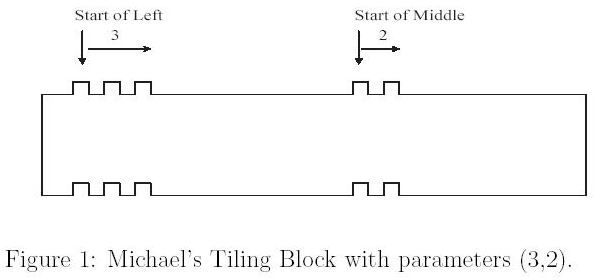POJ 1609 Tilining Up Blocks
| Time Limit: 1000MS | Memory Limit: 10000K | |
| Total Submissions: 3016 | Accepted: 1148 |
Description

Each tiling block is associated with two parameters (l,m), meaning that the upper face of the block is packed with l protruding knobs on the left and m protruding knobs on the middle. Correspondingly, the bottom face of an (l,m)-block is carved with l caving dens on the left and m dens on the middle.
It is easily seen that an (l,m)-block can be tiled upon another (l,m)-block. However,this is not the only way for us to tile up the blocks. Actually, an (l,m)-block can be tiled upon another (l',m')-block if and only if l >= l' and m >= m'.
Now the puzzle that Michael wants to solve is to decide what is the tallest tiling blocks he can make out of the given n blocks within his game box. In other words, you are given a collection of n blocks B = {b1, b2, . . . , bn} and each block bi is associated with two parameters (li,mi). The objective of the problem is to decide the number of tallest tiling blocks made from B.
Input
Note that n can be as large as 10000 and li and mi are in the range from 1 to 100.
An integer n = 0 (zero) signifies the end of input.
Output
outputs.
Sample Input
3 3 2 1 1 2 3 5 4 2 2 4 3 3 1 1 5 5 0
Sample Output
2 3 *
Source
/* 这题主要是求最大升序子序列,但是由于数据规模是n = 10000,所以 如果用常规dp时间复杂度为n ^ 2很容易从超时,所以就想到了二分法DP,时间 复杂度是nlgn 二分法DP查询主要需要维护两个数组: 一个是 longgest[i] 记录以第i个元素结尾可以构成的最长上升子序列 另一个是smallest[l][2] 记录长度为l的最长上升子序列结尾值的最小可能值 先对输入数据排序,然后一次处理每一个元素,当处理到元素i的时候,需要 用二分法去查询i可以插入的合适位置,假设i的查询最终落在k位置上 1)如果k < i,则需要判断i是否可以更新smallest[l] 因为这时input[i]和input[k]有两种大小关系,input[i]不一定比input[k]更小, 由于整个序列 已经按照l进行排序了,所以l不用比较,我们所要做的就是使right值更小,较input[i].r和smallest[k][1], 如果前者小于后者则更新 另外需要更新longest[i] = k; 2)如果k == i,则表示数据i是当前最大的数据 所以置longest[i] = i, smallest[i] = input[i]即可 */ #include <iostream> #include <algorithm> #define MAX_N 10000 using namespace std; struct input { int l, r; }inputs[MAX_N + 1]; bool compare(const input &i1, const input &i2) { if(i1.l < i2.l) return true; else if(i1.l == i2.l) { if(i1.r <= i2.r) return true; else return false; } else return false; } int longgest[MAX_N + 1]; //lonngest[i] 记录以第i个元素结尾可以构成的最长上升子序列 int smallest[MAX_N + 1][2]; //smallest[l] 记录长度为l的最长上升子序列结尾值的最小可能值 int n; int main() { int i, maxLen; while(scanf("%d", &n) && n != 0) { maxLen = INT_MIN; for(i = 1; i <= n; i++) scanf("%d%d", &inputs[i].l, &inputs[i].r); sort(&inputs[1], &inputs[1] + n, compare); int curLen = 0, left, right, lval, rval, mid; for(i = 1; i <= n; i++) { lval = inputs[i].l; rval = inputs[i].r; left = 1; right = curLen; while(left <= right) { mid = (left + right) / 2; if(smallest[mid][1] <= rval) left++; else right--; } longgest[i] = left; if(curLen == 0 || (lval <= smallest[left][0] && rval < smallest[left][1])) smallest[left][0] = lval; smallest[left][1] = rval; if(left > curLen) curLen = left; if(longgest[i] > maxLen) maxLen = longgest[i]; } printf("%d/n", maxLen); } printf("*/n"); return 0; }